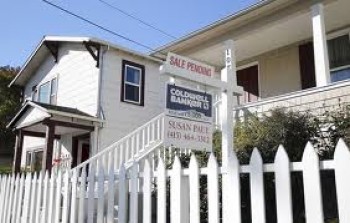
All the talk about housing affordability is usually limited to a single-family detached house. That’s not a reasonable expectation for most people in many work-class cities, so stop complaining, columnist Shelley Fralic writes.
Photograph by: Gerry Kahrmann , Vancouver Sun
The price: $249,000.
Which means, if you negotiated it down to, say, $240,000 and put down 20 per cent and qualify for a three-per-cent, five-year variable mortgage, the monthly payment would be under $1,000, or less than the average rent in Metro.
Right now, in Surrey, one low-rise complex currently has three condos for sale. They have multiple bedrooms and bathrooms, and range from 1,145 to 1,334 square feet. The most expensive is $269,900.
Right now, in Coquitlam and Burnaby, there are 200-plus listings for two-bedroom, two-bath units under $300,000.
And so it goes
.
Do an MLS search on Metro Vancouver condos and townhouses and there are hundreds, yes hundreds, of similar offerings across the region.
There are even a number of two-bedroom condos for sale for less than $300,000 in, wait for it, the city of Vancouver. A two-bedroom, two-bath unit in East Van is on the market for $238,000. It has in-suite laundry, and the building has a gym and pool.
And yet the moaning about unaffordable housing in Vancouver and environs grows ever more loud, especially on the eve of municipal elections. Good lord, the cry goes up, who can afford to live in this place? Who can afford to raise a family here? It’s not right, and the mayor/feds/my parents need to do something about it.
Fuelling the chorus are the endless surveys and comparisons reminding us that if this is heaven on earth, it’s also a mighty pricey postal code.
The latest dose of bad news, delivered recently by this paper, reported that 76 per cent of Metro Vancouver’s 21 municipalities are unaffordable for the average family earning $80,000.
But is that true?
Well yes. And no. Those statistics, like so many published before them, refer to the purchase of single-family homes. The kind of place with no shared walls. No elevators. No pot smoke wafting in from the adjoining balcony. No restrictions on window coverings and tomato planting.
It’s the dream, right? The picket fence. The big backyard for the kids and dog. The two-car garage. We have been conditioned to believe that ownership of a single-family home is the symbol that you have made something of yourself, that you have secured the lottery ticket to ensure a happier family and comfortable retirement.
But why, one wonders, does one’s first home have to be a house?
Oh right. Easy for the big bad baby boomer to say. We had it easy, didn’t we? All those post-secondary jobs for the taking, all that cheap local real estate.
I was born in Vancouver nearly 62 years ago. I have never been able to afford a house in the city.
Nearly 40 years ago, when I was in my early 20s, my young family’s first “house” was a condo in Burnaby, purchased for $49,900 with the help of the CMHC’s Assisted Home Ownership Program. The unit was eventually bought back from us because the complex was leaky, riddled with mould, and eventually torn down.
Our next “house” was a townhouse in a co-op in Newton, a neighbourhood then on the wrong side of the Surrey tracks.
In 1984, facing soaring gas prices and an increasingly brutal commute into Vancouver, we bought a little heritage pile on a postage-stamp lot in New Westminster. It cost $73,000 and the roughly 13-per-cent interest rate demanded a mortgage payment of $800 a month, exactly half of my then take-home pay from this newspaper. Oh, and the bathroom in the basement had a dirt floor.
In 1988, we moved a few blocks over into the house in which I now live. It cost $130,000, and my husband and I lay awake at night wondering how we could possibly afford it, along with two young children to raise.
But I knew then as I know now that the best way to get into the market is to get into the market, even if the dream doesn’t come with stainless steel appliances and isn’t in the dream neighbourhood.
I have equity now, but I will still never be able to afford a single-family house in Vancouver, and gave up that notion long ago, along with the arrogance to think it is somehow my right.
And, as it turns out, Vancouver has nothing on the ’burbs. This is where density and congestion are traded for wide open spaces, family-oriented neighbourhoods and, yes, more affordable housing, single-family and otherwise.
So for the love of God, people, stop complaining about the price of housing in Vancouver. Market forces, not your mayor or mom, determine the cost of housing. Just ask home buyers in New York, Paris and London.
And consider that your home doesn’t have to be a house, and that it doesn’t hurt to start small and think big.
Who knows? Someday, a new generation of Metro Vancouver house hunters might be grouching about your good fortune.
sfralic@vancouversun.com
Click here to report a typo or visit vancouversun.com/typo.
© Copyright (c) The Vancouver Sun
Read more: http://www.vancouversun.com/business/Shelley+Fralic+Housing+affordability+Metro+Vancouver+real+issue+expectations/10326688/story.html#ixzz3HOB324v6




 In the past, financial stability within the senior population had a lot to do with financial stability in the housing market. In fact, home equity was supposed to help with retirement lifestyle. However, as the housing market went downhill, seniors were dramatically affected.
In the past, financial stability within the senior population had a lot to do with financial stability in the housing market. In fact, home equity was supposed to help with retirement lifestyle. However, as the housing market went downhill, seniors were dramatically affected.